High Level Syllogism Questions For SBI PO PDF
High Level Syllogism Questions for SBI PO Prelims and Mains exam. Download SBI PO High Level Syllogism questions on with solutions.
Download High Level Syllogism Questions For SBI PO PDF
105 SBI PO Mocks – Just Rs. 249
Instructions
In the following question three statements are given, followed by two conclusions. You have to consider the statements to be true even if they seem to be at variance from commonly known facts. You have to decide which of the given conclusions, if any, follows from the given statements and select the appropriate option.
Question 1: Statement I: All crows are black
Statement II: Some pigeons are black
Statement III: Some pigeons are bats
Conclusion I: All crows can be pigeons
Conclusion II: All bats can be black
a) Conclusion I only
b) Conclusion II only
c) Both the conclusions follow
d) Either conclusion I or conclusion II follows
e) None of the conclusions follows
Question 2: Statement I: All batsmen are wicket keepers
Statement II: No wicket keeper is a bowler
Statement III: All bowlers are all rounders
Conclusion I: All batsmen being all rounders is not a possibility
Conclusion II: No wicket keeper is an all rounder
a) Conclusion I only
b) Conclusion II only
c) Both the conclusions follow
d) Either conclusion I or conclusion II follows
e) None of the conclusions follows
Question 3: Statement I: Some pins are blades
Statement II: All steels are stainless
Statement III: Some blades are steel
Conclusion I: All blades can be stainless
Conclusion II: All pins cannot be stainless
a) Conclusion I only
b) Conclusion II only
c) Both the conclusions follow
d) Either conclusion I or conclusion II follows
e) None of the conclusions follows
Instructions
In the following question three statements are given, followed by two conclusions. You have to consider the statements to be true even if they seem to be at variance from commonly known facts. You have to decide which of the given conclusions, if any, follows from the given statements and select the appropriate option.
Question 4: Statement I: Some spheres are cubes.
Statement II: No cube is a cuboid.
Statement III: All cuboids are cones.
Conclusion I: No cone is a sphere.
Conclusion II: No cube is a cone.
a) Conclusion I only
b) Conclusion II only
c) Both the conclusions follow
d) Either conclusion I or conclusion II follows
e) None of the conclusions follows
Question 5: Statement I: Some carrots are radishes.
Statement II: No radish is a tomato.
Statement III: All tomatoes are potatoes.
Conclusion I: Some carrots are tomatoes.
Conclusion II: All radishes can be carrots.
a) Conclusion I only
b) Conclusion II only
c) Both the conclusions follow
d) Either conclusion I or conclusion II follows
e) None of the conclusions follows
SBI PO Free Mock Test (Latest Pattern)
Download SBI PO Previous Papers PDF
Question 6: Statement I: Some analysts are coders.
Statement II: All coders are associates.
Statement III: No associate is a consultant.
Conclusion I: All analysts can be associates.
Conclusion II: All consultants can be coders.
a) Conclusion I only
b) Conclusion II only
c) Both the conclusions follow
d) Either conclusion I or conclusion II follows
e) None of the conclusions follows
Question 7: Statement I: Some mangoes are apples.
Statement II: All kiwis are oranges.
Statement III: No mango is a kiwi.
Conclusion I: Some apples can be kiwis.
Conclusion II: All mangoes can be oranges.
a) Conclusion I only
b) Conclusion II only
c) Both the conclusions follow
d) Either conclusion I or conclusion II follows
e) None of the conclusions follows
Instructions
In the following question three statements are given, followed by two conclusions. You have to consider the statements to be true even if they seem to be at variance from commonly known facts. You have to decide which of the given conclusions, if any, follows from the given statements and select the appropriate option.
Question 8: Statement I: Some singers are rappers.
Statement II: No painter is a dancer.
Statement III: All rappers are dancers.
Conclusion I: Some painters can be rappers.
Conclusion II: All singers can be dancers.
a) Conclusion I only
b) Conclusion II only
c) Both the conclusions follow
d) Either conclusion I or conclusion II follows
e) None of the conclusions follows
SBI PO Important Questions (download PDF)
Question 9: Statement I: Some books are papers.
Statement II: All scales are rulers.
Statement III: No ruler is a paper.
Conclusion I: All rulers can’t be books.
Conclusion II: All scales can’t be books.
a) Conclusion I only
b) Conclusion II only
c) Both the conclusions follow
d) Either conclusion I or conclusion II follows
e) None of the conclusions follows
Question 10: Statement I: Some bowls are glasses.
Statement II: All spoons are plates.
Statement III: No plate is a bowl.
Conclusion I: All spoons can be glasses.
Conclusion II: All plates can be glasses.
a) Conclusion I only
b) Conclusion II only
c) Both the conclusions follow
d) Either conclusion I or conclusion II follows
e) None of the conclusions follows
Instructions
In the following question three statements are given, followed by two conclusions. You have to consider the statements to be true even if they seem to be at variance from commonly known facts. You have to decide which of the given conclusions, if any, follows from the given statements and select the appropriate option.
Question 11: Statement I: All pages are books
Statement II: No book is a register
Statement III: Some registers are notebooks
Conclusion I: Some books can be notebooks
Conclusion II: All pages can be notebooks
a) Conclusion I only
b) Conclusion II only
c) Both the conclusions follow
d) Either conclusion I or conclusion II follows
e) None of the conclusions follows
Question 12: Statement I: Some pens are pencils
Statement II: All erasers are pencils
Statement III: No eraser is a ruler
Conclusion I: No pencil can be ruler
Conclusion II: All pens can be rulers
a) Conclusion I only
b) Conclusion II only
c) Both the conclusions follow
d) Either conclusion I or conclusion II follows
e) None of the conclusions follows
Question 13: Statement I: All tables are desks
Statement II: All chairs are class
Statement III: No table is a chair
Conclusion I: No desk can be chair
Conclusion II: No class can be table
a) Conclusion I only
b) Conclusion II only
c) Both the conclusions follow
d) Either conclusion I or conclusion II follows
e) None of the conclusions follows
Question 14: Statement I: All cats are dogs
Statement II: All rats are dogs
Statement III: Some dogs are not lions
Conclusion I: All rats can be lions
Conclusion II: No rat being a cat is a possibility.
a) Conclusion I only
b) Conclusion II only
c) Both the conclusions follow
d) Either conclusion I or conclusion II follows
e) None of the conclusions follows
Instructions
In the following question three statements are given, followed by two conclusions. You have to consider the statements to be true even if they seem to be at variance from commonly known facts. You have to decide which of the given conclusions, if any, follows from the given statements and select the appropriate option.
Question 15: Statement I: Some triangles are pentagons.
Statement II: All pentagons are circles.
Statement III: No circle is a hexagon.
Conclusion I: No circle is a triangle.
Conclusion II: Some triangles can be hexagons.
a) Conclusion I only
b) Conclusion II only
c) Both the conclusions follow
d) Either conclusion I or conclusion II follows
e) None of the conclusions follows
Question 16: Statement I: Some chairs are stools.
Statement II: No stool is a table.
Statement III: All dusters are tables.
Conclusion I: Some dusters can be chairs.
Conclusion II: All tables can be chairs.
a) Conclusion I only
b) Conclusion II only
c) Both the conclusions follow
d) Either conclusion I or conclusion II follows
e) None of the conclusions follows
Question 17: Statement I: All pens are markers.
Statement II: No pen is a pencil.
Statement III: Some pencils are markers.
Conclusion I: All pencils can be markers.
Conclusion II: All markers can be pencils.
a) Conclusion I only
b) Conclusion II only
c) Both the conclusions follow
d) Either conclusion I or conclusion II follows
e) None of the conclusions follows
Instructions
In these questions, the relationship between different elements is shown in the statements. These statements are followed by two conclusions. Study the conclusions based on the given statement(s) and select the appropriate answer.
Question 18: No tree is a herb.
Some shrubs are grass.
No grass is a herb.
Conclusions:
I: No shrub can be a herb
II: No grass can be a tree
a) Only conclusion I follows
b) Only conclusion II follows
c) Either conclusion I or II follows
d) Neither of the conclusions follow
e) Both the conclusions follow
Question 19: All dogs are dragons.
All cats are dragons.
No dragon is a lion.
Conclusions:
I: No dog can be a lion.
II: No cat can be a lion.
a) Only conclusion I follows
b) Only conclusion II follows
c) Either conclusion I or II follows
d) Neither of the conclusions follow
e) Both the conclusions follow
Question 20: Some skies are blue.
No blue is red.
Some red are water.
Conclusions:
I.Some blue can be water.
II. All water cannot be skies.
a) Only conclusion I follows
b) Only conclusion II follows
c) Either conclusion I or II follows
d) Neither of the conclusions follow
e) Both the conclusions follow
Answers & Solutions:
1) Answer (C)

From the diagram, we can see that All crows can be pigeons and All bats can be black.
Hence, option C is the correct answer.
2) Answer (E)

From the diagram, we can see that all batsmen being all rounder is a possibility and some wicket keepers can be all rounders.
Hence, option E is the correct answer.
3) Answer (A)

From the diagram, we can see that all blades can be stainless and all pins can be stainless
Therefore, option A is the correct answer.
4) Answer (E)

From the diagram, we can see that some cones can be spheres. Hence, conclusion I doesn’t follow.
From the diagram, we can see that some cubes can be cones. Hence, conclusion II doesn’t follow.
Therefore, option E is the correct answer.
5) Answer (B)

From the diagram, we can see that no carrot is a tomato. Hence, conclusion I doesn’t follow.
From the diagram, we can see that some all radishes can be carrots. Hence, conclusion II follows.
Therefore, option B is the correct answer.
6) Answer (A)
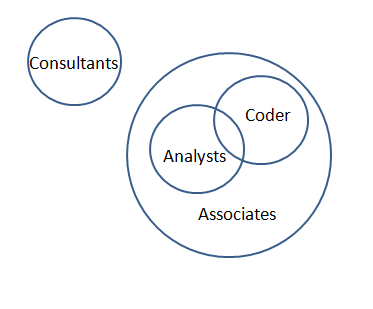
From the diagram, we can see that all analysts can be associates. Hence, conclusion I follows.
All coders are associates and no associate is a consultant. Hence, no consultant is a coder. Therefore, conclusion II doesn’t follow.
Therefore, option A is the correct answer.
7) Answer (C)

From the diagram, we can see that some apples can be kiwis. Hence, conclusion I follows.
From the diagram, we can see that all mangoes can be oranges. Hence, conclusion II follows.
Therefore, option C is the correct answer.
8) Answer (B)

From the diagram, we can see that some no painter can be a rapper. Hence, conclusion I doesn’t follow.
From the diagram, we can see that some all singers can be dancers. Hence, conclusion II follows.
Therefore, option B is the correct answer.
9) Answer (E)
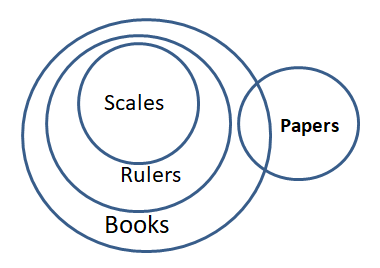
From the diagram, we can see that all rulers can be books. Hence, conclusion I doesn’t follow.
From the diagram, we can see that all scales can be books. Hence, conclusion II doesn’t follow..
Therefore, option E is the correct answer.
10) Answer (C)

From the diagram, we can see that all spoons can be glasses. Hence, conclusion I follows.
From the diagram, we can see that all plates can be glasses. Hence, conclusion II follows.
Therefore, option C is the correct answer.
11) Answer (C)

From the diagram, we can see that All pages can be notebooks and some books can be notebooks.
Hence, option C is the correct answer.
12) Answer (B)

From the diagram, we can see that some pencils can be rulers and All pens can be rulers.
Hence, option B is the correct answer.
13) Answer (E)

From the diagram, we can see that some desks can be chair and some class can be table.
Hence, option E is the correct answer.
14) Answer (C)

From the diagram, we can see that all rats can be lions and no cats can be rats.
Therefore, option C is the correct answer.
15) Answer (B)
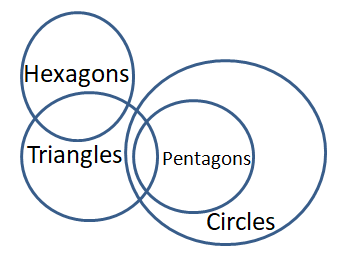
From the diagram, we can see that some circle can be triangles. Hence, conclusion I doesn’t follow.
From the diagram, we can see that some triangles can be hexagons. Hence, conclusion II follows.
Therefore, option B is the correct answer.
16) Answer (C)
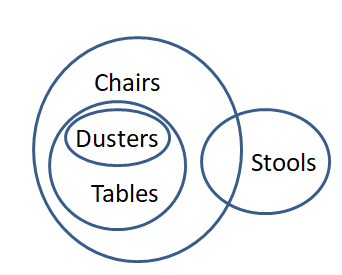
From the diagram, we can see that some dusters can be chairs. Hence, conclusion I follows.
From the diagram, we can see that all tables can be chairs. Hence, conclusion II follows.
Therefore, option C is the correct answer.
17) Answer (A)
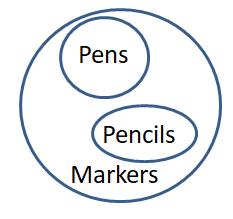
From the diagram, we can see that all pencils can be markers hence conclusion I follows.
No pen is a pencil and all pens are markers. Hence, all markers can’t be pencils. Thus, conclusion II doesn’t follow.
Therefore, option A is the correct answer.
18) Answer (D)
The given statements can be expressed diagrammatically as follows without violating any condition.

As we can see, neither of the conclusions follow. Therefore, option D is the right answer.
19) Answer (E)
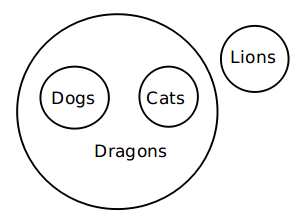
Since all dogs are dragons and no dragon is a lion, no dog can be a lion. Thus, conclusion I follows.
Since all cats are dragons and no dragon is a lion, no cat can be a lion. Thus, conclusion II follows.
Hence, option E is the correct answer.
20) Answer (A)
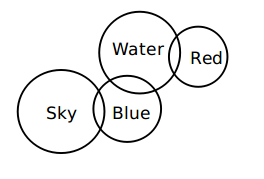
From the venn diagram, we can see that conclusion I is possible.
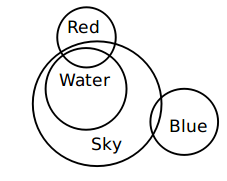
From the venn diagram, we can see that all water can be skies. Conclusion II does not follow.
Hence, option A is the correct answer.
770 Mocks – Just Rs. 199. Enroll Here
We Hope this High Level Syllogism Questions for SBI PO Exam Preparation is very Useful.




![SBI PO Cloze Test Questions PDF [Most Important]](https://cracku.in/blog/wp-content/uploads/2022/10/Cloze-Test-Questions--218x150.png)
